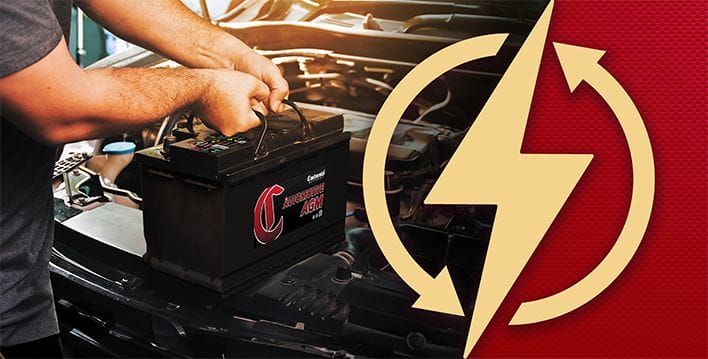
With RV season coming into full swing, be sure to prepare your rig for smooth, safe travels, starting with the heart of the vehicle -- the battery system.
When you and the family prepare for warm weather outings in the RV, it’s a busy time to plan the trip, maintenance the RV, and be fully prepared to head out. Make your summer travels the most fun and least worrisome with good planning and safety checks.
RV Safety Tips
- Conduct a Pre-Drive Safety Check
- Practice S.A.F.E. Cornering
- Slowly approach the turn. It's much easier to speed up in the corner than to have to brake
- Arc the turn, careful to not arc the first swing in the opposite direction, confusing drivers behind about where you really intend to go
- Finish the turn completely. Drivers make a common mistake when they straighten before the back end of the vehicle has cleared the pivot point
- Experience is key. The best way to become a good RV driver is to practice, practice, practice
- Follow the Rule of 20 Percent
Fully loaded rigs have slower acceleration and take longer to come to a full stop than personal passenger autos. To compensate, add 20 percent to everything you do, from increasing your following distance and judging if you have enough clearance, to safely merging into traffic
- Know Your RV’s Height
Sounds simple, but it’s surprising how many people fail to remember their RV is much taller than a car or truck.
- See and Be Seen
Use your turn signals at all times. Let other drivers know your intentions.
6. Avoid Blowouts by Checking Tires Before You Head Out
7. Essential Propane Tank Know-How
- Never paint your tank a dark color, which can absorb the sun’s rays and cause the tank to overheat and explode
- Don't travel with the stove, oven or heater burners lit
- Never refuel with any propane appliance or the engine running
- Make sure older propane tanks are checked to ensure that they have an overfill protection device
- Check the intake and exhaust vents for blockages
- Have your propane tank checked regularly by a certified dealer to ensure that lines are in good shape and not leaking
- Install a propane gas detector
Get more enjoyment from your RV by ensuring there are not breakdowns along the way. Good attention to detail and healthy maintenance will get you off to a stress-free vacation. Which takes us to a very important part of your RV. Your RV battery.
Your RV battery system is a critical component of your rig’s internal setup. It’s what powers everything electric inside your coach, from your overhead vent fan to your HVAC system to your refrigerator.
It’s important to understand that your RV coach battery is actually made up of two distinct systems: a 120-volt AC system and a 12-volt DC system. If you’re driving a motorhome, you also have a regular car battery which is used to start the engine, just as in your regular passenger vehicle.
The 120 volt system is the more powerful battery, which is used to run major appliances like your rooftop air conditioner or your refrigerator in the electric mode. In order to operate this battery, you either need to be hooked up to shore power (as you usually are at most campgrounds) or running an electricity generator that can charge such a large battery. (Solar is usually not a long-term option).
The 12-volt coach system charges when you’re hooked up, running your generator, or when you’re actually driving. This smaller battery system powers things like overhead fans, interior lights, and the water system, and can be used while the RV isn’t hooked up even without a generator — until the battery dies, of course.
Types of RV Batteries
There are a variety of different RV battery choices on the market, and you’ll likely hear persuasive arguments for and against each type depending on who you ask. Here are some of the most common choices:
- Deep-cycle batteries are a type of lead-acid battery, and is similar to the one you can find in boats and golf carts. It’s a lot like a car battery and uses the same chemistry to create and retain power, but a deep-cycle battery produces a steady amount of current over a longer period of time, whereas car batteries create a lot of current over a short period of time (since they then charge while you’re driving anyway). Deep cycle batteries come in a variety of subtypes, including flooded wet-cell batteries, absorbed glass mat (AGM) batteries, and gel-type batteries. Each of these have different maintenance needs.
- Lithium batteries are an alternative to traditional lead-acid batteries, including the deep-cycle batteries offered with most modern RVs. Many campers who rig their RVs for solar power generation upgrade to lithium batteries, which, though expensive, offer a variety of benefits over other types: they’re lighter in weight, smaller, and don’t require the same kind of tedious maintenance other types of batteries do. (For example, wet cell batteries require you to check and replenish electrolyte levels, whereas lithium batteries are set to go.) Lithium batteries also have a much longer lifespan than other battery types, and are typically rated for 5,000 cycles — as opposed to the 400 or so cycles most lead-acid batteries get. That said, they cost approximately three times more up front, which can be a decision factor.
RV Battery Maintenance and Storage
Maintaining your RV batteries will depend, to some extent, on what type of batteries you have. As mentioned above, for instance, lithium batteries require little to know upkeep.
But other types of batteries do have maintenance needs, as well as different lifespans. For example, the answer to the question, ”How long do RV batteries last?” will be very different if you’re traveling with lithium ion batteries versus a wet-cell deep cycle battery.
Maintain electrolyte levels in flooded-cell batteries. Over time, flooded-cell batteries lose water with each charge cycle, and this water needs to be replenished. You must use distilled water to help reduce the chance of sulfation, or the formation of sulfate crystals that can occur when the battery plates are exposed to air. Check the batteries at least once per month, and ensure that they’re fully charged before performing the necessary maintenance.
Clean battery terminals to remove any corrosion that has built up. You can use a mixture of one cup of baking soda to a gallon of water or a commercial battery contact cleaning product, and a small brush for scrubbing.
Allowing your batteries to get too low in charge can also increase sulfation. When your batteries fall below 80%, or 12.4 volts, sulfation can begin. So, always recharge your batteries in a timely manner after using them.
Try to recharge your batteries often. For example, if you discharge your battery to 50% every day, it’ll last twice as long as if you’d discharged it to 20% each day. However, also keep in mind that overcharging and hot temperatures also have negative effects on batteries over time.
Recreational vehicles are usually stored away for months during the winter. Batteries naturally discharge over time, so your battery will go flat if you don’t look after it
This will affect the life of your battery. Freezing kills flooded cell batteries. A charged battery cannot freeze.
AGM batteries resist damage from freezing better than flooded cell batteries, but it is important to prevent it from happening.
Consider removing your batteries from the vehicle and taking them home with you. Check the voltage every month and charge it if it falls below 80%. An overnight charge should be sufficient. If it is not possible to take the batteries out of your rig, you will need to take a few precautions to keep your batteries alive.
Firstly, disconnect your house batteries. Appliances such as radios, refrigerators, smoke detectors, and propane detectors consume tiny milliamps over time which can drain your battery. Just because everything is off doesn’t mean it doesn’t consume some form of wattage.
Charge the batteries as they naturally discharge. If you can gain access to your rig while in storage, charge your battery fully once a month.
Unregulated solar panels may fail to maintain a charge — or, even worse, boil off electrolyte.
Converters should also not be left plugged in so they don’t charge the RV battery. This is a guaranteed way of boiling your RV batteries dry quick.
Check on your batteries periodically while in storage. Once a month is sufficient or you may need to buy new batteries next season. If so, locate your nearest Continental Battery distributor for the best quality battery at the best price.






